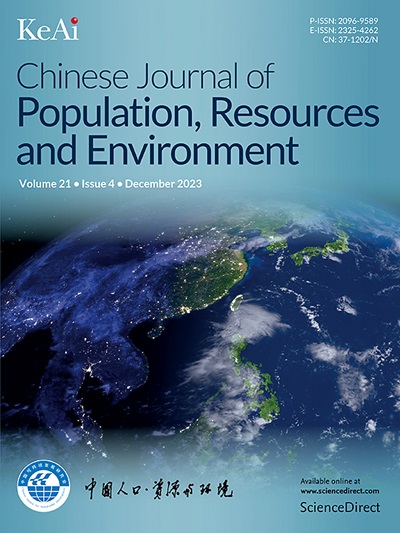土地利用结构调整对农业碳排放的有效降低——以四川省为例
IF 4.8
4区 环境科学与生态学
Q2 ENVIRONMENTAL STUDIES
Chinese Journal of Population Resources and Environment
Pub Date : 2025-09-01
DOI:10.1016/j.cjpre.2025.07.009
引用次数: 0
摘要
中国目前是全球最大的二氧化碳排放国。面对迫在眉睫的气候变化和温室气体排放的挑战,这个国家很脆弱,决心减少排放。因此,本研究采用系统理论方法,探讨农业用地、产值、生产活动、人口以及经济因素对四川省碳排放的影响。为了深入了解农业碳排放的长期轨迹,采用系统动力学模型对2023 - 2040年的农业碳排放趋势进行了预测。研究结果表明:①政策调控对我省企业生产成本有一定影响。模拟结果显示,将第一产业gdp增速控制在2.5%、5%和10%的水平,到2040年碳排放分别只会增加0.24%、0.25%和0.53%,表明有效的政策调控可以将经济增长与排放的大幅增加脱钩,从而凸显了政策调控在排放控制中的关键作用。②调整农业经济增长速度和政策,可以有效降低全省农业用地用地风险。③单一政策影响有限,多措并举对碳减排效果显著。例如,包括减少农药使用和边际农田转耕在内的综合策略,到2035年可将农业用地碳排放量分别降低3.48%、5.30%和7.47%,到2040年可降低1.67%、2.76%和3.65%。总体而言,这些结果强调了政策协调、市场调控和土地利用调整在推进低碳农业发展方面的有效性。本文章由计算机程序翻译,如有差异,请以英文原文为准。
Effective reduction of agricultural carbon emissions via land-use- structure adjustment: A case study of Sichuan Province, Southwest China
China is currently the largest emitter of carbon dioxide globally. The nation, vulnerable to the imminent challenges of climate change and greenhouse gas emissions, is determined to reduce emissions. Thus, by adopting a systems-theory approach, this study is aimed at examining how the agricultural lands, output values, production activities, and populations, as well as the economic factors, influence carbon emissions in Sichuan Province. To offer insights into the long-term agricultural carbon emission (ACE) trajectories, a system dynamics model is used to predict the emission trends from 2023 to 2040. The findings indicate the following: ① policy regulation exerts influence on the ACE in the province. As per the simulation results, regulating the gross domestic product growth of the primary industry at 2.5%, 5%, and 10% will only increase the carbon emissions by 0.24%, 0.25%, and 0.53%, respectively, by 2040, indicating that effective policy regulations can decouple economic growth from substantial increases in emissions, thereby underscoring their pivotal role in emission control. ② Regulating the agricultural-economy growth rate and policies can effectively reduce ACEs in the province. ③ While single policies exert limited influence, combining multiple measures significantly boosts carbon reduction. For example, comprehensive strategies, including reduced pesticide use and marginal farmland conversion, can lower agricultural land carbon emissions by 3.48%, 5.30%, and 7.47% (by 2035) and 1.67%, 2.76%, and 3.65% (by 2040). Overall, these results emphasize the effectiveness of coordinated policies, alongside market control and land-use adjustments, in advancing low-carbon agricultural development.
求助全文
通过发布文献求助,成功后即可免费获取论文全文。
去求助
来源期刊

Chinese Journal of Population Resources and Environment
ENVIRONMENTAL STUDIES-
CiteScore
4.30
自引率
1.10%
发文量
791
审稿时长
79 days
期刊介绍:
The Chinese Journal of Population, Resources and Environment (CJPRE) is a peer-reviewed international academic journal that publishes original research in the fields of economic, population, resource, and environment studies as they relate to sustainable development. The journal aims to address and evaluate theoretical frameworks, capability building initiatives, strategic goals, ethical values, empirical research, methodologies, and techniques in the field. CJPRE began publication in 1992 and is sponsored by the Chinese Society for Sustainable Development (CSSD), the Research Center for Sustainable Development of Shandong Province, the Administrative Center for China's Agenda 21 (ACCA21), and Shandong Normal University. The Chinese title of the journal was inscribed by the former Chinese leader, Mr. Deng Xiaoping. Initially focused on China's advances in sustainable development, CJPRE now also highlights global developments from both developed and developing countries.
 求助内容:
求助内容: 应助结果提醒方式:
应助结果提醒方式:


